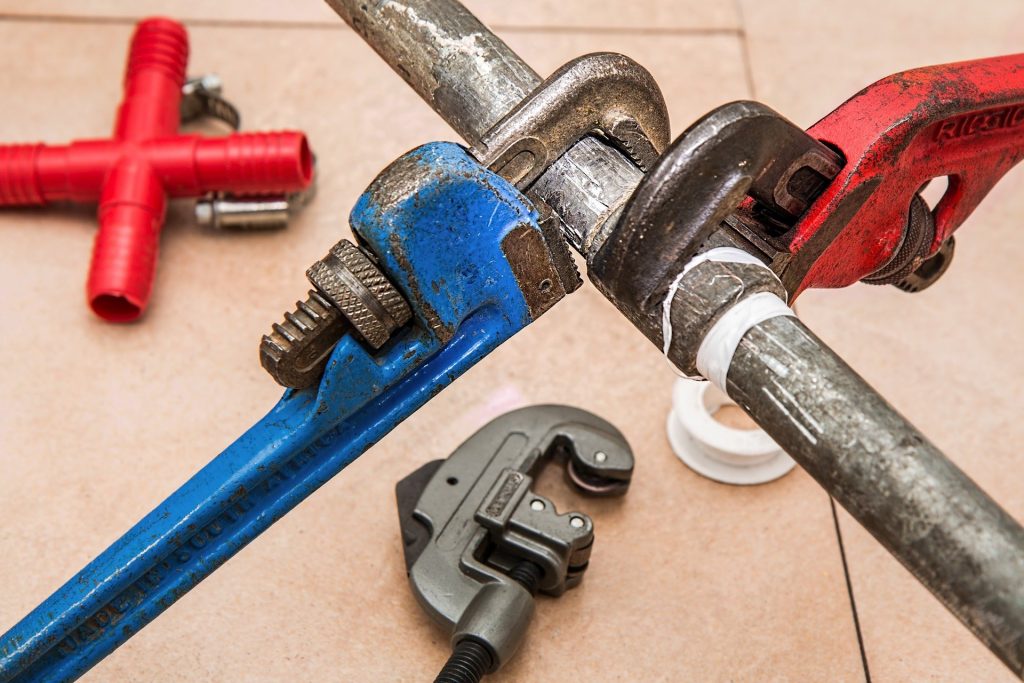because we’ve got your back.
It’s not just a pipe dream, because you can still do it on your own! Running water lines in your house comes down to knowing what tools you’ll need, and how to use them to repair or install brand new pipes. Once you’ve learned that, you’re ready to start or back on track for everything related to your water lines installation and repairs.
Whether you’re learning to repair existing pipes or install new ones, DIY plumbing installations are not only for experts in the field. You can fix or install pipes once you know the materials you need and what to do with them.
If you find any part of the process too complex and live in Missoula, don’t hesitate to get in touch with us at Plumb-Tech!
How Do Water Lines Work?
First, water enters your house through a main water supply line, which is underground. Next, in the house, the main water connects to the water heater. At the water heater, the water line splits in two. One branches off for cold water, while the other stays connected for hot water.
The cold water line splits from the water heater, and directly has connections to each water appliance. Since the water from the water main is already cold, it can go straight to appliances for cold water.
On the other hand, the water in your hot water line is heated by the water heater before connecting to water appliances. For a full explanation of this process, click here.
Before you go any further in this plumbing guide, this is a reminder to turn off your water main from the shutoff valve, which is likely to be in your basement, before beginning any plumbing work below.
Repairing Existing Pipes
First off, let’s dive into the guide for existing pipes. Especially when your plumbing problems are so minor, you don’t want to call a plumbing expert and pay money. You can do it yourself! There are some quick and easy solutions for minor problems to your pipes that will get your water running perfectly again in your home.
Temporary fixes:
- If you detect a problem like small holes, also called “pinholes”, you can simply block the hole with duct tape or electrical tape. As for what brand to buy, it doesn’t matter as long as it’s a good quality, heavy-duty tape. You don’t want to cheap out and get dollar store tape, because it may lead to worse problems if it peels off. Also, it is highly recommended to look into permanent solutions. This is something to hold you for a few days or weeks until you solve the problem with a more secure fix.
- You can also get a pipe repair clamp, which is designed for such purposes. It works by tightening the clamp on the pipe with screws. It’s a fix that will take you no more than 5 minutes! For more information on using a repair clamp see this video here.
Bigger Fixes:
A more permanent solution to damaged pipes is installing a compression fitting. Purchase a fitting size according to your pipe size.
You’ll need to cut off the area of the pipe that’s damaged where the compression fitting will go. You can measure the compression fitting to the pipe and mark cut lines with a marker before making a cut. For copper pipes, you can get a pipe cutter at any hardware and home improvement store. As for PVC pipes, you can use a handsaw or pipe ratchet cutter.
Installing the fitting is quite simple. You’ll have to twist in on both pipe ends where you made cuts. Once the fitting is on, you can rus water again smoothly in your home.
DIY Plumbing Installation: How to Install a Water Line
In this section, we’re going to cover how to install a water line. After reading, you’ll understand what materials you’ll need to get started and how to run water lines in a house. But first, as with repairing water pipes, you absolutely must turn off the water main from the shutoff valve.
Step 1: Get the right materials
Before starting your water pipes installation, it’s necessary to get all the right parts. We’re going to go through installing PEX, because copper pipes are becoming more obsolete as PEX pipes are proving to be easier to install and more durable. Also, you’ll get to avoid soldering if you use PEX pipes, which can be hard for a non-expert plumber.
Here are the essential materials you’ll need for your water lines installation:
- PEX pipes. Determine the amount to buy according to your needs. Consult sources on water lines installation for a new house for the amount to buy. Also, the pipe size you get should match what you currently have. Pick up enough blue, red, and white pipes, which signify warm or cold water.
- Crimp Rings. These are what keep your materials on the pipe tight.
- PEX pipe cutter. For cutting your pipe to your desired length.
- Pipe elbow fittings. “Elbows” are connector pieces for two pipes.
- Brass push-to -connect fittings. These are easy-to-use straight fittings.
- PEX crimping tool. This tool will crimp your brass rings.
- Deburring tool. This handy tool has a dual-purpose: to remove rough edges from cut pipes, and to determine depth for the fitting installation.
- Go/no-go gauge. A necessary tool that determines whether the installation worked.
- Crimp removal tool.
- Disconnect clip.
- Marker.
- Tape measure (optional).
Step 2: Cut the Pipes
Now that you have all your materials, you’re ready to make the first cut. When cutting PEX pipes, you’ll need to use a pipe cutting tool. There are other tools that can work, but it’s more risky as it isn’t intended for the PEX material.
Pipe cutters have scissor blades on them, so you’ll use them like you would use an ordinary pair of scissors. Before you cut, you can use a tape measure and mark where to cut, if you don’t feel so confident eyeballing it. Once you cut your pipes to the required length, you’re ready to start putting pipes in their place.
Step 3: Assembling the Pipes
With “Elbows”:
- First, take a pipe that you want to install, and slide down a brass crimping ring on a side, and it won’t matter which side it is. It should be about a quarter-inch to an eighth-inch from the edge.
- Then, insert the elbow fitting into the pipe opening.
- Use the pipe crimping tool on the brass ring. You’ll know that you’re done when you hear a “pop” sound. Your ring should be tightly secure on the pipe.
- Lastly, use the go/no-go gauge: You will use this little mechanism to determine whether your crimped ring is good to go. Place the “go” side for the appropriate size to the ring, and if it fits perfectly, then you’re good. Then, turn it around to the “no-go” side. On this side, if it doesn’t fit then you’re good to go.
Removing Rings:
In case you make a mistake or want to redo what you’ve done, then there’s a simple solution for it. Take your pipe cutter, and cut the pipe close to the ring. Next, with your removal tool, insert it in the removed pipe and cut on the ring. This should allow the elbow to come off easily.
With Push-to-connect Fittings:
If you’re using a push-to-connect fitting, it’s even simpler than the elbows!
- This one has a plastic insert inside, which will go in the pipe opening.
- Grab your deburring tool and slide the pipe into the corresponding size as far as it goes.
- With your marker, mark where the depth gauge tool ends. This mark is as far as your sharkbite fitting will go.
And that’s it! You’re good to go.
Removing push-to-connect fittings:
Take a disconnect clip, and clip it on the pipe behind the connector. Use it to slide off the connector. It should come off easily.
Connecting PEX to copper pipes:
Part of your water lines installation may include connecting a PEX pipe to a copper pipe. Many people are getting rid of copper pipes because it’s not so durable and needs to be maintained. If you’re installing new water lines, it’s possible you’ll have to connect your pipes to pre-existing copper pipes. In order to do this, you’ll have to do what is called soldering or “sweating the joints”.
“Sweating the joints” is a process involving soldering the pipes with a torch that joins it together, creating a metal alloy. For a full walkthrough of soldering, see this video.





